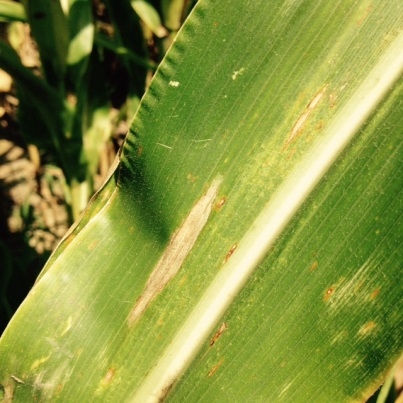
Fact Sheets And Publications

Northern Corn Leaf Blight
Northern corn leaf blight (NCLB) is a disease of corn caused by the fungus, Exserohilum turcicum. Severe outbreaks of the disease can cause up to 30-50% yield loss in dent corn if the disease is established before tassel [1]. NCLB also causes significant reduction in quality in sweet corn and silage corn. This publication will outline how to identify the disease, review its lifecycle, as well as appropriate management options for growers.
Disease Identification
NCLB is favored by moderate temperatures and wet, humid weather. Frequent rainfall, high humidity, or fields prone to extended periods of heavy dews may be at risk for developing NCLB. Symptoms generally appear first on the lower leaves, but may move higher in the canopy as the disease progresses. Leaf blades, sheaths, and ear husks may show symptoms on susceptible hybrids.
Early symptoms appear as long, narrow tan lesions running parallel to the leaf veins. As the disease develops, these narrow lesions will expand to form long, oblong, or “cigar-shaped” tan to gray lesions, which are a diagnostic symptom of NCLB (Figure 1). These cigar-shaped lesions will eventually coalesce over time and may cover a significant portion of the leaf. Under the appropriate conditions, small fungal spores may be produced inside the lesions and appear as tiny black or dark green specks upon observation with a hand lens.
Disease Cycle
E. turcicum overwinters in infected corn residue on the soil surface. As temperatures begin to rise in the spring the fungus will produce spores on the surface of the residue. These spores are then dispersed by wind, rain, or irrigation to the lower leaves of a new corn crop where they may germinate and infect a susceptible hybrid. Infection occurs during wet, humid weather with temperatures between 64 to 84°F [2], which is cooler than temperatures optimal for a common similar disease, Gray leaf spot. Persistant moisture on the foliage is essential in disease development; spores will not germinate unless there is 6 to 18 hours of water on the leaf surface [2]. Lesions generally form within one or two weeks after infection. Within lesions spores are produced that can be rain or wind dispersed up the plant and to adjoining areas. As the growing season comes to an end and plants are harvested, the pathogen overwinters on infected residue.
Management
The most effective practices for NCLB management are hybrid selection and cultural decisions. If infection is established during the growing season in a field it may be beneficial to apply a fungicide, but proper timing and application is critical.
Hybrid Selection
It is a good idea to plant a hybrid with some level of resistance to NCLB, especially if planting into a field with a history of the disease. Check with your seed provider to determine the NCLB rating for hybrids you are growing if NCLB has been an issue in the past.
Crop Rotation
Rotating away from corn for one or two years can help decompose residue and reduce inoculum at a local level. Soybeans, small grains, and vegetables are good rotations for managing NCLB. Avoid sorghum or sudangrass as they can be alternate hosts for E. turcicum.
Tillage
Tilling the soil can bury and accelerate the decomposition of infected corn residue. If tilling an infested field, be sure to clean tillage equipment before moving to a new field to avoid spreading the pathogen to new locations.
Fungicide Application
If a field becomes infested and environmental conditions remain favorable for NCLB development, a fungicide application may be profitable. Fungicide applications between VT and R3 have been shown to have the greatest efficacy against this disease.
References
1. Lipps, P. and Mills, D. Northern corn leaf blight. Extension FactSheet. Ohio State University Extension.
2. Wise, K. 2011. Northern corn leaf blight. Diseases of Corn. Perdue Extension.
UD Cooperative Extension
This institution is an equal opportunity provider.
In accordance with Federal law and U.S. Department of Agriculture policy, Cooperative Extension is prohibited from discriminating on the basis of race, color, national origin, sex, age, or disability.
